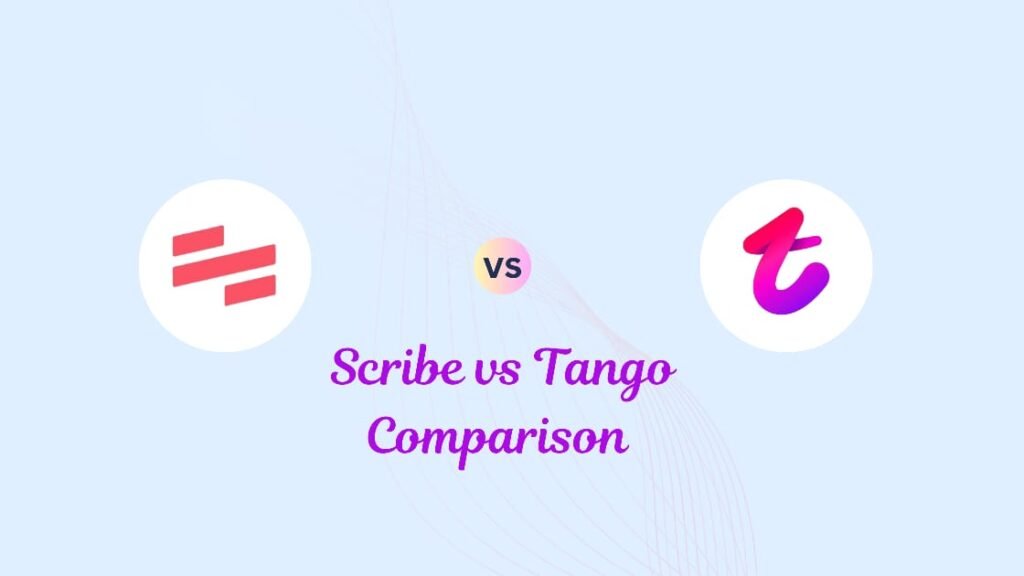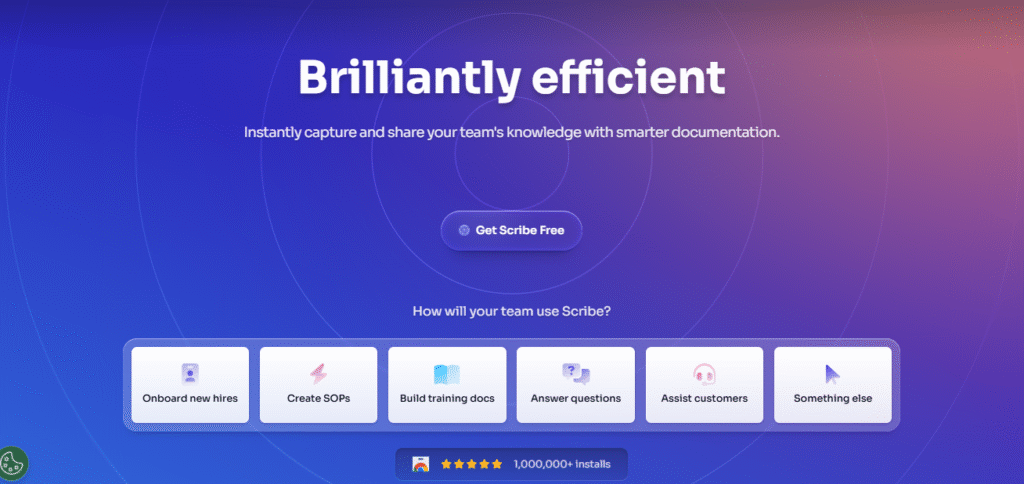By Abiola Gbolahan
Edited By Fredrick Oladipupo

Table of Contents
1. Introduction
Today, remote-friendly work culture, clear and consistent process documentation is no longer a luxury, it’s a necessity. Whether you’re onboarding new hires, streamlining repetitive tasks, or standardizing team workflows, having solid Standard Operating Procedures (SOPs) in place can save time, reduce errors, and boost productivity across the board.
Enter AI-powered SOP generators like Scribe and Tango , the two leading tools revolutionizing how teams capture and share workflows with just a few clicks. But which one truly delivers the smartest experience for documenting processes? That’s exactly what this blog explores.
We’ll compare their features, automation capabilities, ease of use, collaboration strengths, and more. Whether you’re part of a remote team or managing complex internal operations, this side-by-side breakdown will help you choose the right solution for your needs.
2. Platform Overview: Scribe vs Tango
When it comes to choosing between Scribe vs Tango, understanding their platforms and how they function is very important especially for teams managing complex workflows or operating in remote-first environments. Both tools offer unique capabilities, but their approach to documentation and user experience varies.
2.1 Scribe
Scribe is a robust platform built for teams that need fast, clean, and professional process documentation. It shines in environments where speed, clarity, and customization matter.

Scribe automatically captures your screen activity to create step-by-step guides, no manual typing required. It’s available via both web and desktop apps (Windows and macOS), making it perfect for documenting both browser and local desktop processes. Unlike browser-only tools, Scribe’s desktop recorder works offline, a big win for enterprise security or field teams.
Scribe Features
- Auto-generate guides from screen activity in real time.
- AI-enhanced documentation with smart titles and contextual step descriptions.
- Multiple export options: PDF, Markdown, HTML for easy sharing and archiving.
- Embed-ready content for tools like Confluence and Notion.
- Enterprise-grade security: role-based access controls, audit trails, and data compliance.
- Customizable screenshots with the ability to blur sensitive information.
- Offline recording capability, great for desktop processes or secure environments.
2.2 Tango
Tango is a lightweight, browser-first tool designed for seamless SOP creation, onboarding, and internal knowledge sharing especially within remote teams. It functions primarily as a Chrome extension, with a beta desktop version for Mac and Windows also available.

Tango excels in automated step detection, auto-inserting screenshots and instructions with zero formatting effort. It’s perfect for teams that want visual-rich documentation with minimal manual input. The auto-branding features make Tango especially attractive for businesses that want consistent, branded guides for training or external use.
Platform Highlights
- Chrome Extension with expanding desktop support.
- Auto-detects user actions (clicks, scrolls, text entries) and generates guides instantly.
- Smart screenshot insertion with built-in styling.
- Auto-branding options for logos, colors, and fonts.
- Export to sharable URL, PDF, Notion, Confluence, and LMS platforms.
- Collaboration tools for team-based sharing and workspace organization.
3. TL;DR: Quick Comparison for Busy Leaders
If you don’t have time to read the full breakdown, here’s a quick glance at how Scribe and Tango compare across the key metrics that matter for documenting and scaling SOPs.
| Feature | Scribe | Tango |
|---|---|---|
| Best For | Process documentation, SOPs, client-facing workflows | SOPs, onboarding flows, internal training, and remote team guides |
| Key Strength | Fast capture, polished UI, intuitive sharing | Step-by-step accuracy, auto-branding, great for non-technical users |
| AI Features | Smart titles, auto-generated descriptions, instant page builds | Auto-step detection, smart screenshots, contextual instructions |
| Collaboration Tools | Team workspaces, shared folders, permissions | Shareable links, workspace insights, roles-based access |
| Customization | Step editing, company logo, branding in Pro+ plans | Auto-branding, style presets, export to PDF/URL |
| Platforms Supported | Web, Desktop (Mac & Windows), Chrome Extension | Chrome Extension, Web, Desktop App (Beta phase for Windows/macOS) |
| Export Options | PDF, HTML, Markdown, Word | PDF, URL, Notion, Confluence, LMS embed codes |
4. Pricing Comparison: Scribe vs Tango
Pricing is a key factor when choosing between Scribe and Tango, especially for growing teams or enterprises scaling their documentation needs. Both tools offer free versions to get started, but their paid tiers differ in terms of features, flexibility, and user limits.
4.1 Scribe Pricing
Scribe offers a Free Plan with core functionality, allowing individuals to create unlimited guides with basic customization. However, teams and power users will find real value in the paid plans.
| Plan | Price | Key Features |
|---|---|---|
| Free | $0 | Unlimited guides, basic sharing, Chrome extension |
| Pro(Team or Personal) | $12 for team and $23 for personal per user/month (billed annually) | Branding, guide analytics, export options, shared workspaces |
| Enterprise | Custom pricing | Role-based access, audit trails, advanced integrations, dedicated support |
4.2 Tango Pricing
Tango’s pricing is equally competitive, with a strong free offering and slightly lower entry point for paid plans. It’s well-suited for remote teams or those looking to scale up quickly without heavy upfront costs.
| Plan | Price | Key Features |
|---|---|---|
| Starter (Free) | $0 | Unlimited workflows, Chrome extension, limited sharing |
| Pro | $20/user/month (billed annually) | Custom branding, export to PDF/URL, team management tools |
| Enterprise | Custom pricing | Role-based permissions, content insights, integrations with LMS/Confluence |
5. Export & Embedding Options
When it comes to sharing and storing documentation, both Scribe vs Tango offer flexible export and embedding capabilities but with some key differences that may affect your choice.

Scribe stands out with its wide range of export formats. Users can export guides as PDF, HTML, and Markdown files, making it easier to integrate documentation into different platforms or use cases. In addition, Scribe supports Notion embeds and public share links, allowing seamless sharing across teams or external stakeholders.


Tango, while equally capable in the sharing department, offers a more streamlined export experience. It supports PDF export and public share links, and also allows users to embed guides into Notion. However, it does not currently support HTML or Markdown export formats, which may be limiting for teams that need more customizable or developer-friendly outputs.
6. Use Case: Scribe vs Tango
Not sure which tool fits your specific needs? This quick-use case guide highlights where Scribe or Tango performs best based on real-world workflows.
| Use Case | Best Tool |
|---|---|
| Creating SOPs for internal tools | Scribe |
| Onboarding new hires with visual guides | Tango |
| Customer support workflow documentation | Scribe |
| Sharing branded how-to guides with clients | Tango |
| Embedding tutorials in Notion/Wiki | Both |
| Offline documentation support | Scribe |
6. Security & Team Controls
In Scribe vs Tango comparison, Both tools provide essential enterprise-grade security features, including user access controls, SSO (Single Sign-On), and SOC 2 compliance. These ensure that organizations can protect sensitive workflow data while managing access across teams. Additionally, both platforms offer audit logs and permission settings under their Enterprise plans, giving administrators full visibility and control over documentation activities.
However, a key difference lies in offline functionality. Scribe supports offline recording through its desktop app for Windows and Mac which is ideal for environments with limited internet access or for documenting desktop-based workflows. Tango, in contrast, is primarily web-focused and lacks offline capabilities, making it more suited for browser-based documentation needs.
7. Final Verdict: Scribe vs Tango
If you’re looking to create fast, AI-enhanced documentation across both web and desktop workflows, Scribe is the clear winner. Its auto-generated step-by-step guides, multiple export formats, offline recording, and enterprise-grade controls make it ideal for tech-heavy and security-conscious teams.
On the other hand, Tango shines when you need polished, branded SOPs for onboarding or client-facing walkthroughs. Its browser-first interface, smart screenshots, and sleek visual presentation make it a great choice for remote teams or companies looking to impress stakeholders.
Explore More Tools Comparison and Reviews below:
For more comparisons that may help refine your team’s tech stack, check out these insightful reviews:
Demio vs Livestorm: Top Marketing Webinar Tools Compared in 2025 – A deep dive into webinar platforms suited for marketers.
Dorik vs Carrd: Best Lightweight Landing Page Builder in 2025 – Ideal for teams building fast, simple landing pages.
Lendio Business Loans: Unlocking Freelance/Business Funding – How freelance businesses can tap financial support.
Google Workspace vs Microsoft365: Which is Better for Businesses? – A productivity suite showdown for enterprises.
Duolingo AI vs Babbel: Which offers a better AI-driven language learning experience? – Comparing AI-enhanced tools for language learners.



Pingback: Survicate vs Typeform: Best for User Research & Feedback Loops - Platform Adviser